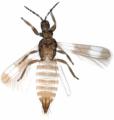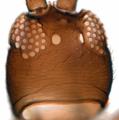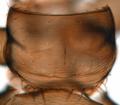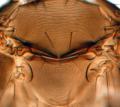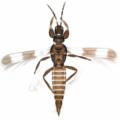Orothrips kelloggi
Recognition data
Distinguishing features
Both sexes fully winged. Body, legs and antennae brown to dark brown, fore tarsi and parts of fore tibiae sometimes paler, basal half of antennal segment III yellow; fore wing with three dark transverse bands, at base, medially and at apex. Antennae 9-segmented, distal segments not forming a unit, segments III – IV each with two linear sensoria that protrude apically as a small cone. Head with 2 irregular rows of small setae behind eyes; compound eyes weakly prolonged ventrally but without enlarged ventral ommatidia; maxillary palps with distal segment subdivided. Pronotum posterior margin with about 7 pairs of short but prominent setae. Metanotum reticulate, median setae near posterior margin. Fore tarsus with strongly recurved ventral hamus. Fore wing broad with apex rounded, cross veins prominent. Abdominal tergites with no sculpture medially; tergite X trichobothria about as large as a setal base. Sternites III–VII with 4 pairs of marginal setae at or close to margin, supernumerary setae on VII close to margin.
Male abdominal tergite I with paired longitudinal ridges less than half as long as the tergite.
Related and similar species
Three species are known in the genus Orothrips, two from California and one from the Mediterranean region of southern Europe (Marullo & Mound, 1994). These three species are unusual amongst the Aeolothripidae in having two sensoria on the third antennal segment.
Taxonomic data
Current valid name
Orothrips kelloggi Moulton
Original name and synonyms
- Orothrips kelloggi Moulton, 1907: 43
- Orothrips keeni Moulton, 1927: 183
Family placement
Aeolothripidae
Biological data
Life history
The larvae, having fed in flowers in spring, drop to the soil and spin a cocoon in which to pupate (Bailey, 1949).
Host plants
Adults have been collected from the flowers of many shrubs in spring, but particularly from Arctostaphhylos pungens flowers (Ericaceae), sometimes together with O. yosemitii.
Tospoviruses vectored
None
Crop damage
None
Distribution data
Area of origin
Western North America
Distribution
British Columbia, Oregon, California, Arizona.

